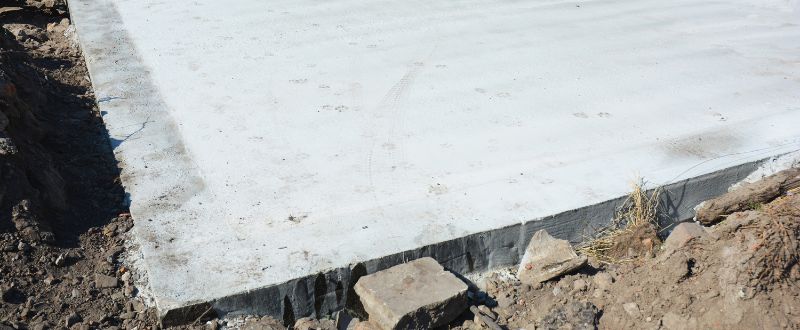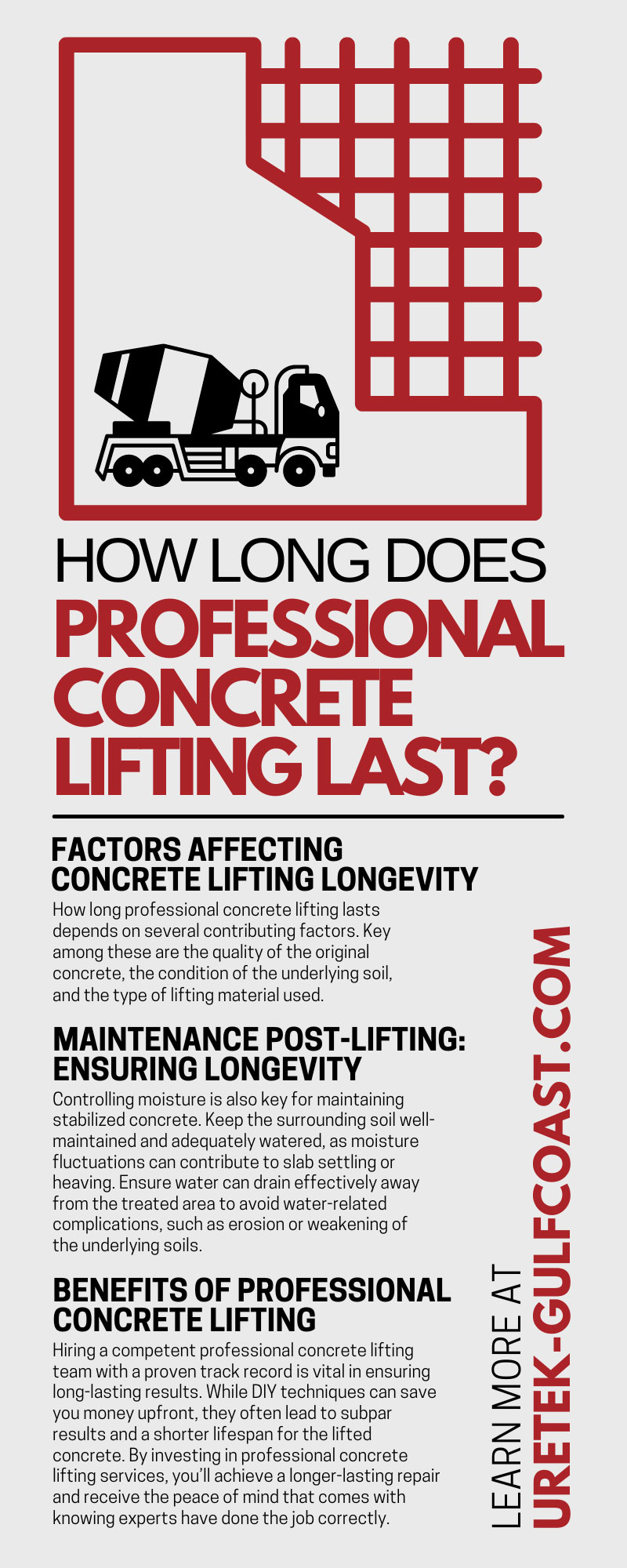Concrete lifting is a popular solution for homeowners and commercial property owners looking to improve the levelness of uneven or sunken concrete surfaces. A key question often asked among clients is: how long does professional concrete lifting last? The answer to this question can vary due to several factors, such as the type of concrete lifting service used, environmental factors, and follow-up maintenance.
Overview of Concrete Lifting Processes
When deciding to invest in professional concrete lifting, understanding the available processes will help you make an informed decision. The two prevalent forms of concrete lifting are mudjacking and polyurethane foam lifting, also called polyurethane injection.
Mudjacking
Mudjacking involves drilling 1”-2” holes in the sunken concrete and pumping a slurry mixture of water, soil, and cement beneath the slab to raise and stabilize it. While this treatment costs less than foam jacking, the slurry mixture is heavier than foam. The density of the slurry mixture puts additional weight on the underlying soil, increasing the likelihood of concrete settling.
Polyurethane Foam Lifting
Foam jacking utilizes a lightweight, expansive polyurethane foam injected beneath the sunken concrete through small, drilled holes, each about the size of a penny. The foam expands and hardens within minutes, lifting the concrete slab back to its original position. It offers several advantages over traditional mudjacking, such as minimal invasiveness, faster cure time, and longer-lasting results due to its lightweight nature and waterproof properties.
Factors Affecting Concrete Lifting Longevity
For some, mudjacking lasts for five to seven years before the concrete starts to settle again. On the other hand, the results of polyurethane foam lifting can last for 20 years or longer. Foam lifting is a long-term solution for sinking concrete.
How long professional concrete lifting lasts depends on several contributing factors. Key among these are the quality of the original concrete, the condition of the underlying soil, and the type of lifting material used.
Quality of the Original Concrete
High-quality concrete tends to respond better to lifting and stays stable for longer. Several variables influence the durability and strength of the concrete, including the following.
- Proper mix design: The proportion of cement, aggregates, water, and admixtures used in the concrete mix will directly impact its strength, durability, and longevity.
- Appropriate curing time: Curing is a critical phase in the concrete hardening process. Allowing the concrete to cure properly will enhance its strength, durability, and longevity.
- Adequate reinforcement: Reinforcing the concrete with steel bars or fibers can significantly improve its structural integrity, reducing the chances of cracks or damage after the lifting process.
Soil Conditions
Unstable or shifting soils can significantly reduce the lifespan of lifted concrete. Expansive clay soils, for example, can cause the concrete to heave or settle repeatedly over time, leading to a reduced duration for the lifted concrete.
Poorly compacted or loose soils can also shift under the weight of the concrete, leading to voids, or holes, in the soil. Voids create instability because they provide no support for the concrete above, leading to sinking or uneven surfaces as the concrete attempts to settle into these empty spaces.
Professional concrete lifting companies will analyze the soil composition and select the appropriate lifting material, ensuring a more stable and long-lasting repair. By choosing a professional concrete slab lifting, you’ll benefit from their expertise in dealing with a variety of soil conditions and their ability to tailor solutions to your property’s needs.
Concrete Lifting Material
Different lifting materials have different tolerances for environmental conditions, which is why the choice of lifting material significantly impacts the longevity of the repair. Mudjacking uses a slurry that, due to its weight, can put additional pressure on the underlying soil, causing potential resettlement over time.
Polyurethane Foam for Water Damage Protection
Unlike other materials that may be susceptible to water damage, polyurethane foam is impermeable to water. This resistance ensures that the foam will not erode or break down over time due to moisture exposure, thereby maintaining its lifting properties and effectiveness for a longer period.
Additionally, water-resistant polyurethane foam may mitigate the risk of further soil erosion beneath the concrete slab. Sealing off the area underneath the slab prevents water from penetrating and washing away the soil, a common cause of concrete sinking in the first place. Additionally, the polyurethane aggregates loose soil as it expands.
Polyurethane Foam for Void Filling
The lightweight foam places less strain on the substrate, preventing further sinking. It also expands and hardens to create a secure lift. When the foam expands, it pushes the soil and eliminates voids, creating a solid, durable base and preventing further shifting.
Maintenance Post-Lifting: Ensuring Longevity
Proper maintenance is essential to guarantee that the lifted concrete lasts as long as possible. If possible, inspect the concrete directly for signs of cracking or other damage. If you cannot observe the concrete, signs of damage may include an uneven surface or cracks in walls. Call your foundation repair team if you suspect any problems.
Controlling moisture is also key for maintaining stabilized concrete. Keep the surrounding soil well-maintained and promote plant growth to hold help keep soil in place. Ensure water can drain effectively away from the treated area to avoid water-related complications, such as erosion or weakening of the underlying soils.
Benefits of Professional Concrete Lifting
Hiring a competent professional concrete lifting team with a proven track record is vital in ensuring long-lasting results. While DIY techniques can save you money upfront, they often lead to subpar results and a shorter lifespan for the lifted concrete. By investing in professional concrete lifting services, you’ll achieve a longer-lasting repair and receive the peace of mind that comes with knowing experts have done the job correctly.
The benefits of opting for professional concrete lifting include:
- Extensive experience dealing with various environmental conditions
- Industry-standard materials and equipment for reliable results
- Warranties and guarantees for work performed
Professional concrete lifting offers a robust and long-lasting solution for uneven and sinking concrete surfaces. Factors such as the quality of the original concrete, soil conditions, type of lifting material, and post-lifting maintenance influence repair longevity.
Choosing professional services ensures quality work, expert handling of various conditions, and a guarantee for the work performed, ensuring the durability of your concrete structures. Contact URETEK ICR Gulf Coast to schedule an estimate for residential or commercial concrete lifting services in Houston.


